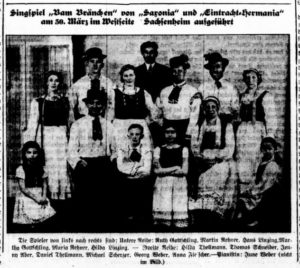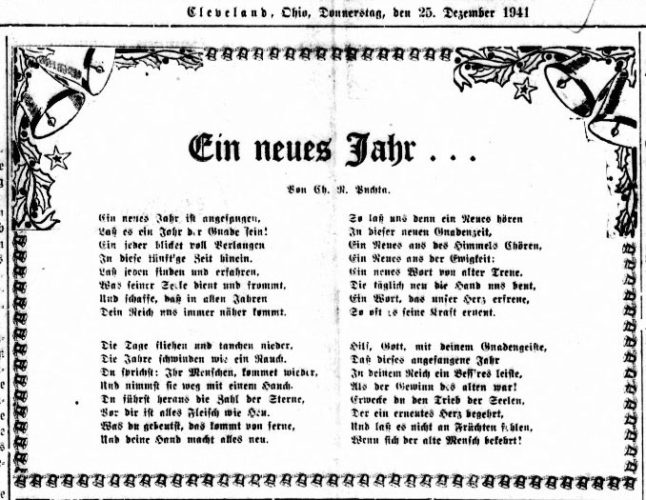Hungarian-German Newspaper Now on Chronicling America!

A newspaper dedicated to the community of Hungarian-Germans in Ohio is now on Chronicling America! You can visit the site to browse and explore issues of the Cleveland Siebenbürgisch-Amerikanisches Volksblatt, 1939-1954.
Hungarian-Germans, or Transylvanian-Saxons, were ethnic Germans who had been invited to Transylvania in the 12th century by the Hungarian king, Geza II, to defend the southeastern border of Hungary against Central Asian invaders. These settlers continued to come to the area throughout the 12th and 13th centuries. They called Transylvania “Siebenbürg,” meaning “seven towns,” for their original seven settlements. While not all the German settlers were Saxons, it became the shorthand for these German settlers.

By the 19th century, the Transylvanian-Saxons had lived in Transylvania for centuries, no longer identifying as Germans, though continuing to speak the language. In the mid-19th century, nationalism took root in the region, and the ruling Hungarians began a process of Magyarization, attempting to erase the languages and cultures of all non-Hungarians. At the same time, ethnic Romanians were trying to take over Transylvania to include it in a new Romanian state. These were the conditions that led many Transylvanian-Saxons in the 19th century to immigrate to the United States. In the 20th century, World War II and the rise of Communist regimes caused many more to leave what was by then Romania, and seek refuge in Austria and Germany, as well as North America. Canada has a large population of Transylvanian-Saxons, as do Idaho, Colorado, and Ohio.
The Siebenbürgisch-Amerikanisches Volksblatt (“Transylvania-American Peoples Journal”) was established in Cleveland in 1907 as Die Neue Hiemat (“New Home”), changing names twice before becoming the Volksblatt in 1917. While classified as a Hungarian-German paper, the Volksblatt was “devoted to the interests of all German nationalities.” In 1919 it became the official organ of the Central Association of Transylvanian-Saxons in America, and after 1939 it also represented the Central Association and the Singers Association of the Transylvanian-Saxons of America and the Transylvanian-Saxons Juniors Association. The Volksblatt included news from Northeast Ohio, Pennsylvania, New York, Illinois, and Michigan, as well as national news and international news. Local content consisted mainly of event calendars for the social and fraternal clubs which the Volksblatt served, church news, and wedding announcements. There were also excerpts from novels and listings of radio programs. An average of one page per issue was published in English.

In 1971, the paper became known as the Saxon News Volksblatt, which is still published in Cleveland today by the Alliance of Transylvanian Saxons. The Alliance of Transylvanian Saxons is a fraternal benefit society that was founded in 1902. It helped the new Saxon immigrants find security for their families, while staying connected to the Saxon community through language, traditions, and social activities. Early editors of the Volksblatt included Moritz Weinberger, Joseph Kundtz, and John Reich, before Georg Schneider took over from 1917 to 1952, followed briefly by Walter Eckstein until 1954. Under Schneider, the paper reached a circulation high of 9,600 in 1930 before falling to 4,954 in 1950. The Volksblatt is currently provided to members of the Alliance, and continues to report on national and local groups, as well as Saxon news from Europe.
Explore the history of this and other immigrant communities in their own words through newspapers digitized for Chronicling America and numerous hardcopy and microfilm editions of newspapers held by cultural heritage institutions across the country. To learn more about foreign language newspapers, including tips on translating content into English, check out our “Researching with Foreign Language Newspapers,” “Working with German Fraktur” and “Using Online Translation Tools” YouTube videos.
Thanks to Bronwyn Benson, Quality Control Technician for the National Digital Newspaper Program in Ohio, for this week’s post!
Chronicling America is the collaborative project of the National Endowment for the Humanities, Library of Congress and state partners, like the Ohio History Connection, to preserve and provide increased access to America’s historic newspapers through the National Digital Newspaper Program. By the end of 2018, the Ohio History Connection will have contributed over 400,000 pages of Ohio’s historic newspapers, including over 100,000 of foreign language content. For more information, visit the National Digital Newspaper Program in Ohio Project Website.



Leave a Reply
You must be logged in to post a comment.